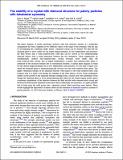Por favor, use este identificador para citar o enlazar a este item:
http://hdl.handle.net/10261/26899COMPARTIR / EXPORTAR:
 SHARE
BASE SHARE
BASE
|
|
| Visualizar otros formatos: MARC | Dublin Core | RDF | ORE | MODS | METS | DIDL | DATACITE | |

| Campo DC | Valor | Lengua/Idioma |
|---|---|---|
| dc.contributor.author | Noya, Eva G. | - |
| dc.contributor.author | Vega, C. | - |
| dc.contributor.author | Doye, Jonathan P. K. | - |
| dc.contributor.author | Louis, Ard A. | - |
| dc.date.issued | 2010-06-21 | - |
| dc.identifier.citation | Journal of Chemical Physics | en_US |
| dc.identifier.issn | 1089-7690 (online) | - |
| dc.identifier.uri | 10261/26899 | - |
| dc.description.abstract | The phase diagram of model anisotropic particles with four attractive patches in a tetrahedral arrangement has been computed at two different values of the range of the potential, with the aim of investigating the conditions under which a diamond crystal can be formed. We find that the diamond phase is never stable for our longer-ranged potential. At low temperatures and pressures, the fluid freezes into a body-centered-cubic solid that can be viewed as two interpenetrating diamond lattices with a weak interaction between the two sublattices. Upon compression, an orientationally ordered face-centered-cubic crystal becomes more stable than the body-centered-cubic crystal, and at higher temperatures, a plastic face-centered-cubic phase is stabilized by the increased entropy due to orientational disorder. A similar phase diagram is found for the shorter-ranged potential, but at low temperatures and pressures, we also find a region over which the diamond phase is thermodynamically favored over the body-centered-cubic phase. The higher vibrational entropy of the diamond structure with respect to the body-centered-cubic solid explains why it is stable even though the enthalpy of the latter phase is lower. Some preliminary studies on the growth of the diamond structure starting from a crystal seed were performed. Even though the diamond phase is never thermodynamically stable for the longer-ranged model, direct coexistence simulations of the interface between the fluid and the body-centered-cubic crystal and between the fluid and the diamond crystal show that at sufficiently low pressures, it is quite probable that in both cases the solid grows into a diamond crystal, albeit involving some defects. These results highlight the importance of kinetic effects in the formation of diamond crystals in systems of patchy particles. | en_US |
| dc.description.sponsorship | This work was funded by Grant No. FIS2007-66079-C02-01 of Dirección General de Investigación Grant No. MODELICO-CM P2009/ESP-1691 of Comunidad Autónoma de Madrid, and Grant No. 200980I099 of CSIC. J.P.K.D. and A.A.L. are grateful for financial support from the Royal Society. | en_US |
| dc.publisher | American Institute of Physics | en_US |
| dc.relation.ispartofseries | 132 | en_US |
| dc.relation.ispartofseries | 234511 | en_US |
| dc.rights | openAccess | en_US |
| dc.subject | Computer simulation | en_US |
| dc.subject | simple models | en_US |
| dc.subject | phase diagram | en_US |
| dc.subject | thermodynamics | en_US |
| dc.title | The stability of a crystal with diamond structure for patchy particles with tetrahedral symmetry | en_US |
| dc.type | artículo | en_US |
| dc.description.peerreviewed | Peer reviewed | en_US |
| dc.relation.publisherversion | 10.1063/1.3454907 | en_US |
| dc.type.coar | http://purl.org/coar/resource_type/c_6501 | es_ES |
| item.openairetype | artículo | - |
| item.grantfulltext | open | - |
| item.cerifentitytype | Publications | - |
| item.openairecristype | http://purl.org/coar/resource_type/c_18cf | - |
| item.fulltext | With Fulltext | - |
| Aparece en las colecciones: | (IQF) Artículos | |
Ficheros en este ítem:
| Fichero | Descripción | Tamaño | Formato | |
|---|---|---|---|---|
| 1.pdf | 1,04 MB | Adobe PDF |  Visualizar/Abrir |
CORE Recommender
Page view(s)
320
checked on 18-abr-2024
Download(s)
217
checked on 18-abr-2024
Google ScholarTM
Check
NOTA: Los ítems de Digital.CSIC están protegidos por copyright, con todos los derechos reservados, a menos que se indique lo contrario.
